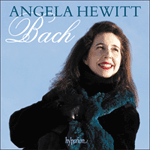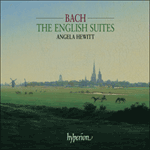
Welcome to Hyperion Records, a British classical label devoted to presenting high-quality recordings of music of all styles and from all periods from the twelfth century to the twenty-first.
Hyperion offers both CDs, and downloads in a number of formats. The site is also available in several languages.
Please use the dropdown buttons to set your preferred options, or use the checkbox to accept the defaults.

The Sarabande is in 3/2 time, denoting a slower tempo than usual. It is in two distinct parts: the initial statement which is slightly bare and can certainly be ornamented on the repeats, and then a fully written-out double which should be played afterwards. It is written in the style brisé made famous by the seventeenth-century lutenists (simply meaning that the arpeggiation is written out as an integral part of the line). Here a certain amount of rubato seems not only possible but desirable, especially in the second strain. It is a perfect example of how the harmonic content dictates the emotional response. The two Gavottes are linked melodically, with the theme of the second one being a direct quote of the first except in the major mode. The walking bass we encounter in the Courante is present again in Gavotte I, but changes register to the upper parts for part of the second section. Gavotte II is yet another musette, heard in the distance.
The set of English Suites is brought to a magnificent conclusion with the D minor Gigue—a masterpiece of ingenuity and virtuosity. The contrapuntal energy of the Prelude is now renewed in full force for a fugue that is completely demonic. It is written in 12/16 time, so should be brisk. The pedal-point effect of the Prelude is apparent in the fugue subject and in the long trills which must be played simultaneously (not an easy feat!). The quavers should be spiky and insistent, yet always follow the line. The syncopations caused by the ties are there for extra effect. This fugue is a perfect example of ‘mirror’ writing, which was taken a step further by Bach in his Art of Fugue. The first seven bars of the second section are, to take just one example, an exact inversion of the first seven bars of the beginning of the Gigue. We don’t need to know this to feel its tremendous power, but when we analyse what is there, it becomes all the more remarkable.
from notes by Angela Hewitt © 2003
Ecrite à 3/2, la Sarabande fait appel à un tempo plus lent qu’à l’accoutumée. Elle est en deux parties distinctes: l’énoncé initial légèrement nu peut certainement être orné dans les reprises et un «double» entièrement réalisé qui doit être joué ensuite. Elle est écrite dans le style brisé que les luthistes du XVIIe siècle avaient rendu célèbre (le mouvement arpégé est noté sur la partition et incorporé à la ligne). Une certaine dose de rubato semble non seulement nécessaire mais désirable, en particulier dans la seconde mouture. Voici un exemple parfait de la manière dont le contenu harmonique dicte une réponde émotionnelle. Du point de vue mélodique, les deux Gavottes sont apparentées puisque le thème de la seconde est une citation directe de la première, dans le mode majeur. La ligne de basse allante que nous avions rencontrée dans la Courante est reprise dans la Gavotte I, mais change de registre dans la seconde section pour aller vers les parties supérieures. La Gavotte II est une autre musette que l’on entend dans le lointain.
Le recueil des Suites anglaises est conduit à une conclusion magnifique avec la Gigue en ré mineur—un chef-d’œuvre d’ingénuité et de virtuosité. L’énergie contrapuntique du Prélude est renouvelée avec une force formidable complètement démonique. Elle est écrite à 12/16, et doit donc être rapide. L’effet de pédale du Prélude est apparent dans le sujet de la fugue et dans les longs trilles qui doivent être joués simultanément (ce qui n’est pas une mince prouesse!). Les croches doivent être pimentées et insistantes, tout en suivant la ligne. Les syncopes causées par les liaisons ajoutent des effets supplémentaires. Cette fugue est un exemple parfait d’écriture «en miroir», que Bach poussa à un degré supplémentaire dans son Art de la Fugue. Les sept premières mesures de la seconde section sont, pour ne citer qu’un exemple, une inversion exacte des sept premières mesures du début de la Gigue. Nous n’avons pas besoin de le savoir pour en ressentir la puissance extraordinaire, mais en l’analysant, tout devient plus remarquable encore.
extrait des notes rédigées par Angela Hewitt © 2003
Français: Isabelle Battioni
Die Sarabande steht im 3/2-Takt und hat damit ein langsameres Tempo als gewöhnlich. Sie weist deutlich zwei Teile auf: zunächst eine recht schlichte Anfangsaussage, die jedoch in den Wiederholungen verziert werden kann, und dann ein voll ausgeschriebenes „Double“, das danach gespielt werden sollte. Es bedient sich des style brisé, der durch die Lautenspieler des 17. Jahrhunderts berühmt wurde (und einfach bedeutet, dass die Arpeggierung als wesentlicher Bestandteil der melodischen Linie ausgeschrieben ist). Hier scheint ein gewisses Maß an Rubato nicht nur möglich, sondern sogar wünschenswert zu sein, insbesondere im zweiten Teil. Es wird hier sehr gut illustriert, wie der harmonische Inhalt die emotionale Reaktion diktieren kann. Die beiden Gavotten sind melodisch miteinander verbunden, indem das Thema der ersten in der zweiten direkt zitiert wird, mit dem einzigen Unterschied, dass es nun in Dur erklingt. Der schreitende Bass, den wir bereits in der Courante angetroffen haben, erscheint nun auch in der ersten Gavotte, gleichwohl mit einem Registerwechsel nach oben im zweiten Teil. Die zweite Gavotte ist wiederum eine Musette und erklingt wie aus Ferne.
Die Englischen Suiten werden mit der fabelhaften d-Moll Gigue zu Ende gebracht: ein geniales und virtuoses Meisterstück. Die kontrapunktische Energie des Präludiums kehrt nun mit voller Kraft in dieser absolut dämonischen Fuge zurück. Sie steht in 12/16 und sollte daher recht flott gespielt werden. Der Orgelpunkteffekt des Präludiums taucht im Fugenthema und in den langen Trillern auf, die beide gleichzeitig gespielt werden müssen (kein einfaches Unterfangen!). Die Achtel sollten spitz und insistierend sein, dabei jedoch stets der melodischen Linie folgen. Die Synkopierungen, die durch die Bindungen entstehen, sorgen für noch mehr Effekt. Diese Fuge ist ein sehr gutes Beispiel für „Spiegelungen“, eine Technik, die Bach in der Kunst der Fuge noch weiterführte. Die ersten sieben Takte des zweiten Teils sind, um nur ein Beispiel zu nennen, eine genaue Umkehrung der ersten sieben Takte des Anfangs der Gigue. Man muss über dieses Wissen nicht verfügen, um die ungeheure Kraft des Stücks spüren zu können, wenn man es jedoch analysiert, wird es noch eindrucksvoller.
aus dem Begleittext von Angela Hewitt © 2003
Deutsch: Viola Scheffel
 Bach: Angela Hewitt – The Bach Recordings Bach: Angela Hewitt – The Bach Recordings‘One of the record glories of our age’ THE SUNDAY TIMES. For the first time ever, Angela Hewitt’s complete recordings of the Bach keyboard works on Hyperion are presented in one collection of 27 CDs. This covers nearly 25 years of Angela’s Bach re ...» More |
 Bach: Angela Hewitt plays Bach Bach: Angela Hewitt plays BachAngela Hewitt’s acclaimed recordings of Bach on the piano have received the highest critical acclaim and found their way into thousands of homes, selling nearly 400,000 copies since her recording of the Inventions burst onto the scene in 1994. Now ...» More |
 Bach: The English Suites Bach: The English Suites |

